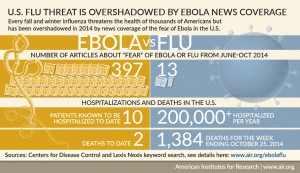Apr 28
2015
Fearful Patient Engagement
Guest post by Judy Chan, president, HealthPro Consulting.
Two big communicable disease scares—Ebola and measles—gripped the attention of the general public recently. They did so with enough strength that the average person on the street spoke out and demanded that actions be taken to protect themselves and families. It was virulent on social media. The total count of Ebola deaths at the end of last year was 5,021 worldwide. The CDC reported 10 Ebola cases treated in the U.S. and two patients died as of January 2015. There were 121 total measles cases in the U.S. this year in 17 states. All but 18 of the measles cases were because of an outbreak that spread from Disneyland in California.
What is remarkable is that these two infectious diseases affected a total of less than 200 people across the nation. Yet it triggered a vigorous response from masses of people who were afraid that they could contract Ebola when the actual chances were significantly lower than dying from a lightening strike. The spread of measles among children erupted into online wars between the vaccinated and unvaccinated.
Contrast this with the lack of concern over the flu vaccine’s low effectiveness against this year’s virus, which the CDC estimates kill 3,300 to 49,000 people in the U.S. every year. Warnings from the CDC that the flu strain this year is worse and getting the flu shot will at least temper the illness seems to have had little effect on increasing vaccinations.
Ebola attracted the public’s attention with such obsessive coverage that the public expected exposed individuals to be quarantined even though an individual had no symptoms to indicate a contagious state. More importantly, contact with fluids of an infected person is necessary to become infected. Contrast this with measles where the air and surfaces an infected person has coughed or sneezed remain contaminated for up to two hours. Measles is contagious up to four days before the telltale rash appears. According to the CDC, about one in every 1,000 children who contract measles will die and 90 percent of the non-immune people close to an infected person will get it.
Fear was the driver for Ebola’s patient engagement. The measles outbreak engaged parents because it raised the issue of the high rate of non-immunized children of a highly contagious and serious disease, but there were no calls to quarantine measles victims and guard them as with Ebola victims.
